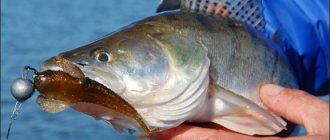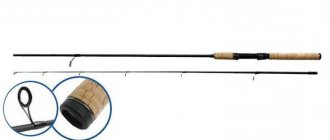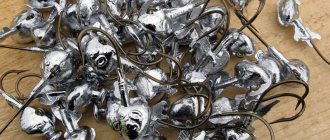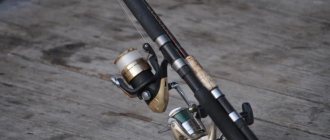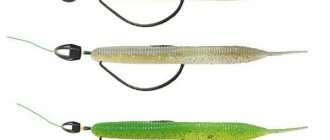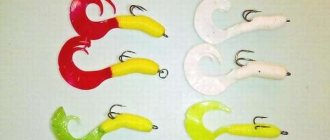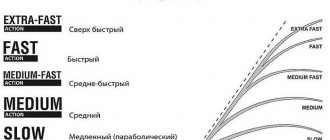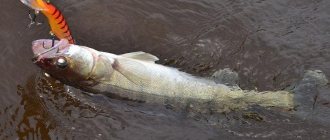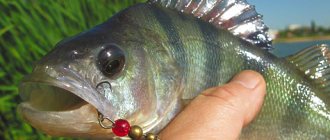As a rule, trophy specimens prefer to be at depth and stay at a considerable distance from the shore. Therefore, it is more effective to get a trophy pike or pike perch using jig equipment.
Jig baits are produced for jig equipment. They consist of two parts: the bait itself and the jig head, a certain weight and a certain shape. The weight of the jig head is selected depending on the fishing conditions. At great depths, heavy baits are used, and in shallows, lighter ones. The shape of the bait is selected according to the nature of the bottom of the reservoir. If the bottom is muddy, then it is preferable to opt for a jig head with a flat base.
The basis of any spinning fishing is the nature of the bait. It is obtained as a result of movements with the rod and winding of the line with the reel. At first glance, everything is very simple and accessible. In fact, everything is much more complicated and success comes as a result of long training.
Spinning for jig
The choice of jig rod is a very important factor influencing fishing performance. The characteristics of the rod must match the characteristics of the bait, otherwise it will not be possible to plausibly move the bait and hook the fish in time. The spinner must feel the bait and control it. It is very important to decide on the fishing conditions: either from the shore or from a boat. Only after determining the main factors that you will encounter while fishing should you start choosing a spinning rod.
If fishing is carried out from a boat, then a long spinning rod is absolutely not needed. On the contrary, with a shorter one, catching a predator from a boat is much more convenient. Therefore, a spinning rod with a length of 1.9 to 2.4 meters is suitable for such conditions.
For fishing from the shore, the following philosophy is suitable: the longer the spinning rod, the better, since you can’t do without long casts. But again, the larger the spinning rod, the heavier it is, and this is an additional load on the hands. Plus, there may be vegetation on the shore of the reservoir, which complicates the use of long rods. In this regard, you can focus on the following dimensions: 2.7-3.0 meters. As practice shows, such a form is absolutely sufficient for fishing from the shore.
All fishing rods are divided into certain categories, including by the nature of the rod's structure. For jig fishing, a fast or super-fast action may be most effective. This is necessary for fast and reliable hooking. In addition, fast action rods respond faster to bites. This is especially important when fishing for pike perch. It has a very powerful jaw, which needs to be broken through by hooking, and besides, the pike perch takes the bait very carefully.
Installation of jig baits (part 1)
As a rule, it should be a reliable rod with suitable test. The test indicates what weight of bait is best to use so that the wiring process is controlled. There are three main groups of rods, separated by test characteristics. The first group is ultralight rods, with a weight of up to 10 grams. As a rule, such rods are convenient for catching perch and other smaller fish. The second group, with dough from 10 to 30 grams, is intended for catching larger predators weighing up to 10 kg inclusive. Such spinning rods are most in demand, as they are more suitable for our fishing conditions.
The last group is rods with a weight of more than 30 grams, which are used for fishing at great depths and over long distances, where heavy jig heads are used. This subspecies is relevant if you have to fish on a river with a fast current.
The material of manufacture also plays an important role. If a fishing rod is made of modern materials, then it is not only durable, but also lightweight. The only drawback of such forms is their high cost, which is inaccessible to a wide range of spinning players.
Spinning rod parameters
All fishing rods are conventionally divided into several categories , which are compiled depending on their nature, including action. For a beginner jig spinner, blanks with fast or super-fast action are perfect, which will allow you to perform high-quality and reliable hooking. In addition, such inventions react more sensitively to bites, which increases the chances of performing an accurate strike at the most opportune moment.
When choosing a reliable fishing rod for fishing with a jig head for pike, perch or pike perch, pay attention to the test load indicators. They indicate the maximum weight of the bait that can be used on a particular form with the ability to control the retrieve. Currently, there are three groups of fishing rods that differ in test characteristics:
- In the first group there are models for ultralight fishing, the test of which reaches 10 grams. It is advisable to buy them when catching small predators, such as perch or pike perch.
- The second group contains forms with a test load from 10 to 30 grams. With their help, you can comfortably catch larger prey, the weight of which reaches 10 kilograms. As a rule, it is these spinning rods that are used by domestic fishermen, as they are suitable for our natural conditions.
- The third group included models with test values from 30 grams. They are especially effective for deep-sea fishing and casting jig baits for pike into remote areas of the reservoir. If you are going to fish on a river with intense currents, then this option is the most suitable.
When choosing a good spinning blank, take into account the material of manufacture. It is advisable to choose good models from trusted manufacturers, which are created on the basis of modern materials with high strength and, most importantly, low weight. However, such fishing tools are not cheap, so a beginner may find them difficult to access .
Jig reel
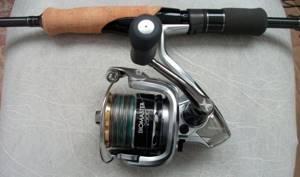
Jig fishing does not require any special equipment such as a reel. Basically, a regular spinning reel of the appropriate size is used. Nowadays, they are increasingly resorting to installing a multiplier reel, although this is not necessary. A multiplier (sea) reel is designed for catching large fish. It will be used, for example, for catching catfish. In all other cases, especially since it is more difficult to operate, it is quite possible to get by with an inertia-free coil that is easier to use.
As a rule, experienced spinningists choose high-quality spinning reels with a special spool coating. If a braided cord is used, a regular plastic spool will wear out quickly. The fact is that braid has abrasive properties. As for ordinary monofilament fishing line, there are no such requirements for the design of the reel.
Best jig reel
When planning to assemble jig tackle with your own hands, it is also important to choose a good reel. And although high demands are not placed on this element, for comfortable fishing it is better to choose high-quality and functional solutions.
In most cases, for this direction of spinning fishing, an inertia-free model with the appropriate size is used. Today, functional multipliers are widespread, but only experienced fishermen know how to use them. Most often, multiplier products are indispensable for catching large-sized prey, for example, for catching catfish. For the average spinning player, a regular, easier-to-use, inertia-free reel will be sufficient.
Experienced fishing masters recommend giving preference to models with a characteristic spool coating. After all, if you wind expensive braid on a plastic spool, it will quickly wear out and completely fail. This is explained by certain features of the structure of the braid, which has abrasive properties. As for the classic monofilament line, it is more stable and is not afraid of such influences.
Jig line
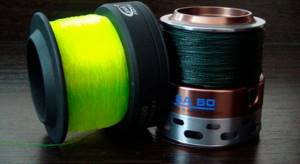
Most fishermen, especially in small rivers and lakes, use monofilament line, although braided line can also be used. Unfortunately, braided fishing line is more expensive than monofilament, but monofilament has a number of disadvantages, such as the presence of memory, increased specific stretch and lower strength compared to braided cord. Although there are fishing conditions when there is no alternative to monofilament fishing line. Some of its disadvantages can easily be turned into its advantages.
Therefore, the choice of fishing line is dictated by fishing conditions. At long distances, it is preferable to use braid, since you need to quickly transfer the bite to the tip of the rod, and at short distances, monofilament is sufficient, since in such conditions its stretchability does not affect the performance so much. In addition, its stretchability helps to absorb the jerks of large fish.
How to properly equip a JIG LURE. 6 ways to rig.
Preparing the fishing line
When rigging a jig bait, it is important to pay special attention to the choice of fishing line. When exploring small rivers and lakes, it is wise to use a time-tested and experience-tested monofilament, although braided cord also does its job well, but it costs much more. At the same time, monofilament fishing line has significant disadvantages, such as:
- The presence of a “memory effect”.
- Low strength.
- Strong stretchability.
In some conditions, the described disadvantages turn into advantages and become irreplaceable.
Therefore, when choosing a fishing line, you need to take into account the situation where the fishing will take place, and also listen to the recommendations of experienced colleagues. For long distances, braids are well suited because they can quickly transfer a bite to the rod tip. For short distances, the monofilament option is quite suitable, since there are no special requirements for stretchability. Sometimes this feature reduces the aggressiveness of large prey's lunges, making it an advantage.
Jig lures
There are two main types of jig baits, depending on what material they are made of.
- Foam rubber baits . These are classic jig baits that are sold in retail outlets. Such baits are easy to make yourself, which is what many fishermen do. The result is inexpensive home-made baits designed for various fishing conditions.
- Silicone baits . Nowadays, such baits are very popular among jig fishing enthusiasts. In retail outlets you can find a huge variety of silicone baits, differing in shape and color. Thanks to the special properties of silicone, it was possible to create baits that imitate not only various fish, but also various animals, as well as insects and other representatives of the underwater world. Various flavors are added to the silicone, which increases the number of bites. This is the so-called edible rubber.
- Combined baits are created by the fishermen from the deteriorated parts of silicone baits. Silicone bonds very easily when exposed to heat. Therefore, by picking up a soldering iron, you can create your own masterpieces.
Catching baits and baits
For modern jig fishing, two types of baits are used:
- Made from foam rubber.
- Silicone products.
If we talk about the first category, it includes many classic baits that are available at a low price in any fishing store. In addition, they are easy to make with your own hands, which is what experienced spinners do. In this case, it is possible to make several inexpensive devices with minimal costs.
In turn, silicone baits appeared much later, but began to rapidly gain popularity, having many advantages. There is a wide variety of silicones on sale in different sizes, colors and shapes. Due to the unique properties of silicone, manufacturers have managed to bring to the market truly catchy jig baits that perfectly imitate the play of real fish, as well as insects or any other inhabitants of the depths. To increase efficiency, flavors are added to silicone, as a result of which the number of bites increases significantly. This produces the popular edible rubber.
Also for jig fishing, combined solutions are used, which are created from old, damaged silicone baits. Due to easy processing under the influence of temperature, silicone that has become unusable quickly becomes a new, functional bait. It is enough to pick up soldering equipment, and perhaps you will be able to invent a real masterpiece.
Mounting the bait
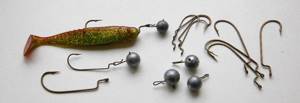
There are several options for jig installation, depending on the nature of the load:
- Rigid jig head mount . This is the easiest way to mount a jig bait. In this case, the jig head is connected to the bait in such a way that the weight is in front of the bait, and the point of the hook comes out from above the bait.
- Flexible mount . This mounting option allows you to get a brighter game of the bait. The bait is put on the hook, and a weight, like a “Cheburashka”, is connected to the hook by means of a winding ring. The equipment can use both regular hooks with a long shank and offset ones. Offset hooks allow you to get a non-snagging bait.
In any case, the main thing is to choose the right hook size so that it matches the size of the bait. Quite often, double or triple hooks are used instead of single hooks. This increases fishing efficiency, but at the same time increases the risk of getting caught on underwater obstacles. You can learn how to properly attach bait to a regular or double hook on the Internet by watching the corresponding video. It is better to see once than to read several times, especially since it is not so easy to describe this process, and even more difficult to apply in practice.
Fishing. Mounting bait on a jig head
Loads

Cargoes vary not only in weight, but also in shape. Despite this, most jig heads are equipped with ball-shaped weights. They are suitable for almost all spinning fishing conditions. In addition to spherical weights, you can also find loads in the shape of a “boot” or “iron”. As a rule, such loads are characterized by the presence of a wide bottom plane, which does not allow it to fall into the silt.
Jig wiring
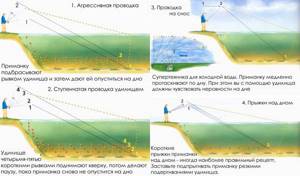
The effectiveness of jig fishing depends on a whole set of factors that one way or another affect the performance. The skill of the spinning player is of no small importance. The ability to correctly present the bait and move it plausibly so that the predator sees its prey in it and decides to attack is one of the main conditions for the effectiveness of the gear.
Classic wiring is a regular step, which is formed either by moving the rod upward or by cyclically winding the fishing line. If a step is formed by the movement of the rod, then after it you need to immediately remove the slack in the fishing line, otherwise you will not be able to detect the bite in time. If you make not one swing of the rod, but several, but shorter ones, you will get a large step, which will include several small steps. Such variety attracts fish more and the result does not take long to wait.
Sometimes even wiring is required, which may be due to the nature of the bait used. If it is a vibrating tail, then moderate, uniform wiring quite plausibly imitates the movement of a fish. Depending on the behavior of the fish, sometimes a slow and sometimes a fast aggressive retrieve is required, which provokes the predator to attack.
Wiring for demolition is used on rivers. In this case, the bait is thrown upstream somewhere at an angle of 45 degrees. The bait begins to sink to the bottom and the current carries it away. Small twitches of the rod make the bait seem to bounce on the bottom, which attracts both pike and zander.
Jig heads
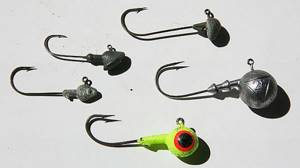
The jig head structurally consists of a hook of the appropriate size, cast into a load of the appropriate shape and weight. As a rule, special hooks with a long shank are used to produce jig heads. The hook is positioned so that its tip always faces upward. Here on the load there is an eyelet for fastening, which is also directed upward. The result is a structure with a mixed center of gravity, which pulls the bait down. This factor makes it easy to control the movement of the bait. The shape of the load can be any, as this does not affect its catchability.
9 ways to install silicone baits part 1
Types of equipment
There are several types of spinning equipment.
Texas

The rig called Texas is characterized by the presence of a weight in the form of a bullet and an offset hook, on which there is a bait in the form of a worm. The weight has a hole running along its axis, as a result of which it can slide along the fishing line. At the bottom of the load there is a recess in the form of a hemisphere in which the upper part of the bait can be hidden. When using an offset hook, its tip can be hidden in the body of the bait, which reduces snags to a minimum.
At the same time, it is necessary to select the correct weight of the load so that it slowly sinks to the bottom. Lures such as worms are especially effective when slowly lowered or moved vertically.
Caroline

This equipment is similar to the previous one, with minor features. This installation is based on the principle of spaced equipment, since the load is located at a distance of 40 cm to 1 m from the bait. In this case, the load can drag along the bottom creating turbidity and attracting fish, and the bait in the form of a worm is in a free state, which leads to its characteristic game.
Other accessories with offset hooks

In the case of using offset hooks, it is possible to use not only worms as bait, but also other types of bait, such as slugs or shads, imitating the movement of a fish. Since the baits have a certain weight, it is not necessary to load them. Such baits catch pike and perch well.
Front hook rig
To minimize the likelihood of snagging, the hooks are equipped with plastic bridges. For this purpose, special spirals with rings are used, which are placed on the hook in the area of its bend. It turns out that the bait is located behind the non-snaking hook. Baits such as worms and slugs are designed to pass through grass easily due to their shape. The hook must be loaded by soldering its shank with lead solder or lead plasticine. As a result, the design will resemble a jig head.
Equipment with a float or wobbler
Such equipment is rare, since it is little known and rarely used by anyone. It is based on a light jig rig, to which a wobbler or horizontal float is added. This is necessary when a fixed immersion depth is required, which provides a horizontal float. Very often the fish attacks the float. In this case, the float can be replaced with a floating wobbler by removing the rear tee.
Drifting bottom rig
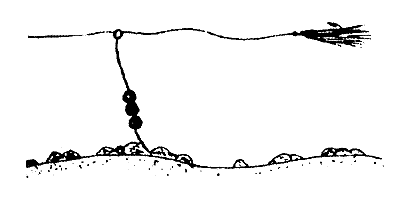
A similar installation is used when fishing in the current. Below the hook with the bait, at a distance of 40-60 cm, a leash with a set of weights, such as a pellet, is attached. In case of snags, the pellets move, freeing themselves from the snags. As a result, the equipment always remains intact.
Petty tyrant

Such equipment consists of a weight attached to the end of the main fishing line. At a distance of 20-30 cm from it there are several leashes with hooks on which baits are placed. With the help of such equipment they catch fish in a vertical line. As a rule, it is used for fishing at sea, where there is significant depth.
Jig rig for pike
As you know, pike have very sharp teeth and can easily bite through ordinary fishing line. In this regard, it makes no sense to attach the bait directly to the fishing line. To prevent the pike from biting off the bait, a metal leash is installed between it and the fishing line. Its length depends on the size of the predator that can peck. As a rule, a 20-centimeter leash is sufficient. When catching large specimens, it is possible to install a 40 cm leash.
Fishing using various jig equipment.
Split shot
This rig has been a hit with rudd and perch over the last couple of years. Its essence is that some kind of bait is tied to the main fishing line, and an ordinary float shot is fixed about thirty centimeters from it. Any small twister, vibrotail or crayfish is suitable as bait. Wiring ranges from uniform to wavy. This equipment is created primarily for shallow places, therefore the maximum load for it is 3 grams.
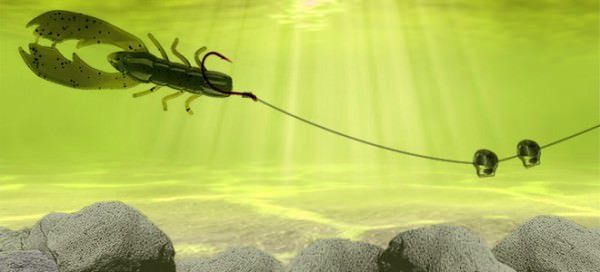
Jig fishing technique
The jig fishing technique is quite simple and effective. It allows you to fish both shallows and deep-water areas of reservoirs. After casting the bait, you need to wait for the bait to reach the bottom. Experienced spinning anglers can easily determine this by the sagging of the fishing line. After this, you can begin wiring. As practice shows, you have to use several wiring techniques to interest a predator. If there are no bites, then proceed to replacing the bait with another, more attractive one, or switch to another type of bait altogether.
When fishing from the shore, you have to make long casts, 70-100 meters, and you can’t do it without a high-quality fishing rod. But this is not the most important thing. The most important thing is to determine a promising place where pike or other fish can stand. You need to look for holes, as well as exits from them. Including the edges, after which you should actively fish them.
Igor 05/05/2017
